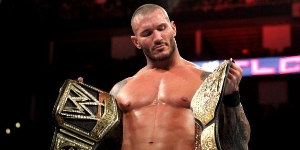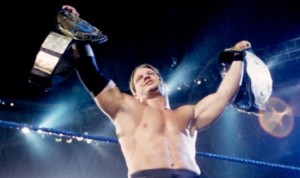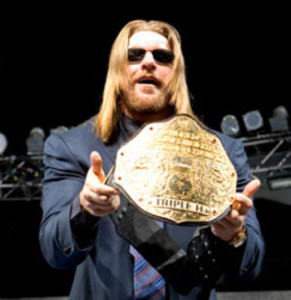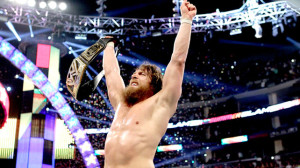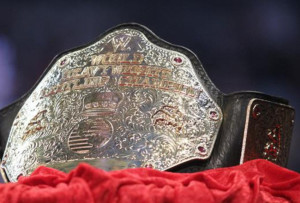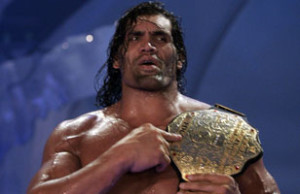We wrestling fans are now on the heels of World Wrestling Entertainment’s unification of their top tier championships – the WWE title and the World Heavyweight title. Randy Orton became the second Undisputed WWE World champion in recorded history following the events of WWE’s “Tables Ladders & Chairs” pay-per-view event.
What makes this WWE title unification interesting is the fact it’s so similar to what happened twelve years ago. After the then-WWF purchased World Championship Wrestling and Extreme Championship Wrestling, the WWF found itself with two major championships (the WWF title and the WCW World title). After disposing of WCW, a tournament to unify the championships was held, ending with former WCW World champion and would-be WWF champion Chris Jericho defeating The Rock and “Stone Cold” Steve Austin on the same night.
Chris Jericho would lose the Undisputed WWF championship to Triple H three months after his triumphant victory, setting the stage for another historic moment – the Brand Extension/Split. WWF/WWE owner Vince McMahon looked to create a civil war in his company by splitting the roster. Thanks to the influx of talent from two now defunct companies, the WWF had enough wrestlers to have a group wrestle on Monday’s “Raw” program while the others fought on Thursday (and eventually Friday) night’s “Smackdown”. The brands’ rosters and their respective General Managers would bicker back and forth over what show was better.
The Undisputed champion had the distinction of having to wrestle on both brands. Thanks to this, the Undisputed championship changed hands three times before settling around the waist of Brock Lesnar. Eventually, Lesnar opted to become the exclusive property of “Smackdown”, leaving “Raw’s” brand major champion-less. “Raw” GM Eric Bischoff decided to reinstate the WCW World Heavyweight title, dropping the “WCW” portion before handing the belt over to Triple H.
As the years progressed, the championships switched bodies and brands. Talented wrestlers and those considered not-so-gifted became the company’s biggest stars. Thanks to the brand split and two major champions in WWE, John Cena and Dave Batista were able to reach unbelievable heights of popularity and main event status. Before Cena and Batista, Chris Benoit and Eddie Guerrero completed life-long goals by winning their brand’s respective titles. Randy Orton became the youngest World champion in wrestling history. Years later, the World title allowed Edge to reach his lofty potential. From Daniel Bryan to CM Punk to Dolph Ziggler to Alberto Del Rio, men now looked upon in high favor by wrestling fans and pundits alike have their names etched in the annals of immortality thanks to there being two major WWE championships.
But it wasn’t all well and good. By 2011, the focus shifted. The World title and its’ champions found themselves no longer considered of the utmost importance. The days of a World Heavyweight championship match headlining “Wrestlemania” or “Summerslam” were gone. No better example of how far the World title had fallen was the championship’s appearance in opening matches at back-to-back “Wrestlemania’s” (WWE’s biggest event of the year). It became apparent that unless a John Cena or Randy Orton held the title, the World championship wasn’t as important as compared to the title it once sat alongside. To obliterate that problem of too many top tier championships, one must be gotten rid of. And thus ended the days of WWE’s World Heavyweight championship as we knew it.
In the end the question must be raised whether or not having two major titles was beneficial for the company. Simply put – absolutely! If not for WWE instating both the WWE and World championships, men like Chris Benoit and Eddie Guerrero (two individuals considered pound-for-pound the best ever) wouldn’t have broken through a believed glass ceiling to headline the twentieth edition of “Wrestlemania”. Dave Batista’s meteoric rise to the top would’ve been stunted without a title to chase after. Superstars who suffered setbacks, but considered incredible talents (men such as Edge, Christian, Rey Mysterio and “King” Booker T.) had an opportunity to take the ball and run with it beyond all expectations.
The loss of WWE’s World Heavyweight championship comes the loss of potential. With two major titles to chase, Edge was able to achieve Hall of Fame status after many years of dredging through midcard. A believed underachiever such as Mark Henry became a bona-fide main event star after defeating Randy Orton for the “big gold belt”. Men like Jack Swagger and Dolph Ziggler might not have the chance to take that next step. Then there’s The Great Khali…. Okay, lets stop there.
Though the elimination of the World title presents a major blow to a roster of great grapplers, it also gives the company an opportunity to definitively separate the chaff from the wheat; to create legitimate singles stars who are not held back by the belief they’re the secondary top tier champion. The belief of “They’re good enough to hold a championship, but not good enough to be the John Cenas or Randy Ortons of WWE” will be gone.
It’s amazing to see just how much things are similar to the days after Chris Jericho became the Undisputed WW(F) champion. One major champion exists instead of two. The roster is bloated, but full of exceptional talent. Established stars are starting to reach the twilight of their careers or moving on to bigger ventures. While those aforementioned sentences might make it sound like WWE is on rocky ground, the uneasiness can and will produce interesting moments, matches, and, most importantly, champions that otherwise would’ve never happened if men were stuck opening the biggest event of the year for WWE instead of headlining like their predecessors. Here’s to the new unified era … that’s reminiscent of the old era.


